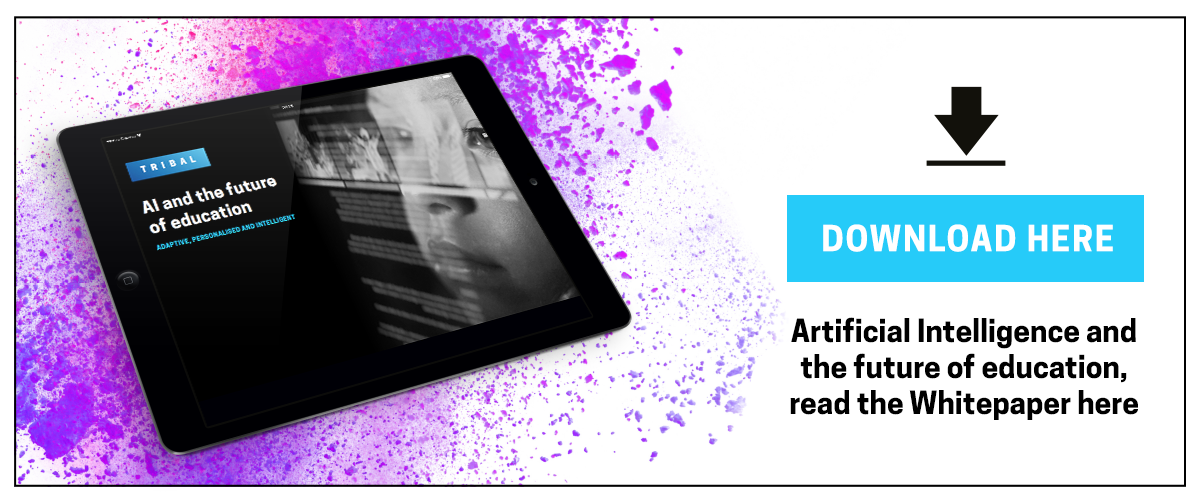How AI is assisting students teachers and administrators today
There are 3 education specific categories in which AI is set to assist institutions in making adaptive, personalised and intelligent decisions. But how far should we trust algorithms with this responsibility? Read on for the latest education use cases and the ‘best case scenario in education’ currently supported by AI….
Today, we’re looking at how educational institutions will be affected by and utilise AI technologies.
Nesta’s Educ-AI-tion Rebooted Report provides a great starting point, suggesting three education specific categories that we need to examine: student-facing, system-facing and teacher-facing AI. Regardless of your position, considering all three categories and the trickle down effects across your organisation will help to paint a picture of the future of AI enabled education. The case studies referenced in this blog are from the UNESCO Mobile Learning Week – AI in Education event held earlier this year…
Student-facing AI
Learners are at the heart of every institution, and most sectors face a wave of learners that are Gen Z digital natives, the first generation raised by personalised algorithmic systems from birth. These learners are increasingly diverse, increasingly socially aware and increasingly expecting fluid, reactive services. Their expectations of an educational environment are no different – both in terms of curriculum delivery, and the support services they require. So how will AI affect them?
1. Virtual assistants/chatbots
It’s likely you’ve seen businesses start to use virtual assistants or chatbots to manage customer support. The early examples of these bots were essentially interactive FAQs, but now they can predict and intelligently manage and answer queries through Natural Language Processing for a more personalised service. Virtual assistants with these capabilities will increasingly be able to help prospective and current students with their queries, saving the valuable time and resources of busy and overstretched administrators. Moreover, the next generation of students will expect interactive virtual assistance available on demand, and deem more static communication with administrators via email or phone to be antiquated and no longer fit for their purpose.
Interestingly, a use case from Old Dominion University found that children were more likely to ask virtual assistants basic questions they were afraid to ask human assistants. This suggests that virtual assistance could in fact provide a more useful service for students, who might be more inclined to ask a student support service chatbot the questions they really need answers to. So as well as alleviating admin resources and student support services, virtual assistance might also be more helpful to students. Of course this use case also raised valid concerns about children being reliant on chatbots and suggested that engagement types should be closely monitored.
Ultimately, the ideal solution is to offer the convenience, flexibility and anonymity of virtual assistance alongside the personal, skilled, and tailored support of administration and student support service professionals. Getting the balance right for each specific institution, taking into account demographics and learner needs will be key.
2. Intelligent learning systems/Computer-assisted learning
Each student has an individual learning style and pace, and the current education system is renowned for it’s limitations in catching and progressing all student types. This is where AI could really make a difference. Newly available data points and insights provided by machine-learning, will enable more powerful student progress analysis, including predictive insights into their performance and making it easier to address pain points through their academic journey as and when and they happen.
Combine this with customisable interfaces, an interactive digital curriculum and intelligently summarised course units – and it makes previously dated pedagogical lesson plans much easier for students to digest.
Furthermore, recent machine learning research from the Medical Research Council at the University of Cambridge has helped identify specialist requirements and assess a more conducive learning environment in schools: previously, children with similar but broad medical conditions such as autism and ADHD were grouped together, despite them having very varied individual learning difficulty areas. Utilising machine-learning, these students’ performance data can be used in detailed assessments of the learning conditions required for distinct cognitive skills development. This can help with improving teaching and parenting interventions and environments. And the great news is that similar methods have already started to be implemented into software learning environments.
However, the shift in this approach to teaching and learning may remove the risk of failure to a fault. After all, learning to fail is an integral part of education. And a more in depth analysis of this student-facing systems potential poses the ethical question of whether it’s right for a computer to decide if a person is appropriate enough for the level of education they are offered? Some things simply can’t be quantified by algorithms and no matter how accurate the intelligence is that you use to ‘predict’ – it’s still just a guess. Removing the human from this decision-making process altogether is unlikely to be the answer.
Add the data privacy and ethical considerations of processing and generating insights from sensitive student information – and the AI in student-facing systems debate rages on…
System-facing AI
In time however, all the systems your institution relies on – from your MIS and LMS to your VLE - will have their automatable, analytical, and predictive technologies bolstered by improved algorithms as a result of AI. This ultimately means those making executive decisions and administrating the institution will be able to make better-informed decisions.
Building on your MIS, you can improve:
- Admission and enrolment: predictive analytics can already be used to measure student suitability and potential to progress through the recruitment funnel.
- Diversity: improved insights can help us truly see and anticipate the biases inherent in large data sets in education that have been present since their inception.
- Timetabling: providing historic data for comparison will alleviate conflicts and timing issues and make timetabling much easier to get right first time.
- School inspections: it’s becoming easier all the time to identify institution pain points to prepare for an inspection – and now its also possible to predict when school inspections are likely to happen.
According to Nesta’s report, all these innovations are welcomed by teachers, students and parents:
“We desperately need new solutions to tackle the mounting pressures on our school system – from excessive teacher workload to lack of social mobility – and many of the [AIEd] tools described in this report have the potential to dramatically improve our school system.”
Teacher-facing AI
Indeed, class sizes and workloads are growing and increasing pressure for teachers to submit and provide data is a constant challenge. Teachers cannot be everywhere at once so being able to constantly monitor learners with active analytical systems that track student progress both in and out of the classroom will certainly help. Teacher-facing systems can also aid in collaborative learning and in catching those who are having issues and would otherwise have slipped under the radar.
Further areas in which AI could assist include:
- Grading – most repetitive grading systems can be automated, with advanced exam input for multiple choice or free text. Recent systems using machine learning can also now grade complicated text based coursework automatically and offer suggestions. Pilot studies in China with 120 million people have found that AI agreed with human graders about 92 percent of the time.
- Attendance recording and analysis - recent software releases now allow facial recognition to check class presence, attendance and behaviour – but this may well be too Orwellian for many institutions at this point in time.
- Digital Assessment & Evaluation – a key opportunity for AI is in identifying at risk students more effectively by analysing and comparing previous and current data sets to spot trends in behaviour and attainment. Recent advances in technology are helping us perform this analysis on larger and larger data sets, more quickly and effectively than ever before.
In all the examples above, we’re talking about making decisions that could fundamentally alter a student’s academic and life path, and most educators would agree that this is not for an algorithm to decide without at least some human input.
So what’s the ‘best case scenario’ for AI in education?
Out of the use cases mentioned above, the HolonIQ survey found that improved learning processes, student customer support, and assessment feedback were creating the most value in education at the moment:“AI is creating the most value for organisations as a tool for assessment and feedback and as a tool to aid the learning process”.
While some of the other developments detailed in this blog are appealing, there are yet to be significant use cases at scale and, as is the case with any disruptive technology or pedagogy change, adoption is likely to be slow. Development is also currently being hampered by the ‘overhyping’ of AI as the ‘silver bullet’ that solves all our problems in education (which it is not!), and a lack of understanding about how to implement AI technologies.
So in our next blog, I’ll be explaining what you can do today to benefit from the latest, proven advances in technology, whilst paving the way for more sophisticated uses of AI in education in the future…
TOPICS:
SHARE THIS ARTICLE:





